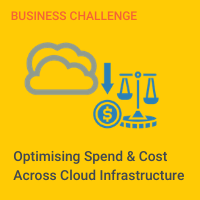
It’s well established that investment in cloud is seeing massive growth, but also trending is adoption of multiple clouds in any single environment. Most organizations today are using two or more cloud providers due to factors such as variety of choice, acquisitions of companies with existing cloud infrastructure, and pioneering DevOps teams that adopted cloud early.
Given cloud-cost control is a top cloud-management concern for organizations, the challenge becomes: How do you efficiently manage multiple clouds when each provider has a separate set of billing tools? Without a single dashboard and a unified view of all cloud activity, managing cloud cost is an inefficient use of engineering time and resources. Organizations need a better way to solve the cloud-cost management issue.

According to Gartner, four providers – AWS, Azure, Alibaba, and GCP – comprise 75 percent of the global cloud market. With such diversity of options comes the possibility of managing multiple, separate cloud bills.
Check out our guide to cloud cost management.
What’s driving multi-cloud cost challenges?
Once cloud projects and workloads go beyond the migration and testing phases, and into at-scale production, all cloud costs are typically allocated and potentially charged back to specific teams. Finance teams find this activity challenging (it’s already challenging enough with the rest of the business), especially with many cloud service providers’ native billing tools. Factor in multiple cloud service providers, and this task becomes quite complicated.
Native billing reports and files only give one view of what IT teams are spending, which means IT must go into each provider tool, find the billings, find the current costs, and summarize them. This is a very manual, time-consuming, and inaccurate process. The best spreadsheets in the world can’t keep up.
Take Bitmovin – a Software as a Service (SaaS) video services company – as a case in point for why organizations need to ditch the spreadsheet in favor of an easier, unified way to view their cloud costs. The company originally tried a DIY approach to using Amazon Web services (AWS), Microsoft Azure, and Google Cloud Platform (GCP) tools separately. It faced a multitude of billing files, discounts, and prepaid services that needed monitoring and controlling. Going through the billing data of each cloud provider tool one-by-one, locating the invoices, and compiling and summarizing the data in spreadsheets proved to be a colossal waste of engineering time and resources.
Recognizing it would be much better to monitor and optimize costs in one place, the company deployed a multi-cloud cost-management platform that provides a single dashboard and unified view of all its cloud costs. Bitmovin is now able to:
- Improve tagging coverage across AWS, Azure, and GCP
- Allocate cloud costs to specific customers to calculate their cost-per-customer
- Identify and shut off dev-and-test instances that were left running
- Monitor and control their multi-cloud costs from one dashboard
You can read more about how Bitmovin solved its multi-cloud cost-management challenge here. The company is a great illustration of what to look for when searching for a better way to manage your multi-cloud costs.







